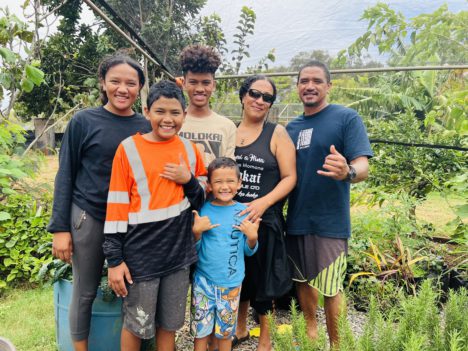Ka‘auwai ‘Ohana Aim for Food Security
By Paul Hanley | Community Reporter

Photo courtesy of Fina Ka’auwai.
“Our goal is to help increase our family’s and our island’s food security by inspiring others to start growing more of their own food,” says Fina Ka’auwai. Fina and her husband Wayne, who grew up living and working on farms on Molokai, are slowly increasing food production for their family of six on their one-acre plot in Ho’olehua.
In addition to hunting, fishing, and growing traditional crops, they have expanded into chickens, aquaculture, and “rainbow” fruits and vegetables. Part of their formula for success has been diversifying their diet. Their lush gardens are bursting with variety.
“Fina made me eat kale and I never ate kale,” says Wayne. “I hated vegetables. Now I need them! And our kids—aged 16, 14, 13, and 6—are like rabbits, they love all this fresh stuff.”
“The kids are a vital part of it,” says Fina. “From farm to table, we make learning fun. They are actively learning along with us as we care for the garden and animals. They are homeschooled now, and farming is a big part of our science curriculum. We started off their school year by growing oyster mushrooms for a science project. We even have our own farm to table ‘cafeteria’ where they assist in preparing healthy meals.”
Passing on subsistence values to their keiki is important to the couple.
“Whether its hunting deer or pig, fishing, or growing crops,” says Wayne, “we are teaching them how to be independent and survive on their own.”
The Ka’auwai ‘ohana’s interest in intensive, regenerative growing methods started recently when a group from Molokai was invited to a farm tour on Maui sponsored by the Hawaiian Farmer’s Union United (HFUU).
“Those farmers helped me think outside the box, compared to the agriculture we grew up with, which included lots of synthetic fertilizers and techniques that, little by little, degraded the soil,” comments Fina. “The farms we visited were all small-scale. There was nothing costly needed, like tractors, so it didn’t take a lot of money to get started. They do what they can with what they have. We saw possibilities and came back inspired. You think: ‘I can do that.’”
For Wayne, creating a healthy environment for growing is key.
“It all starts with soil building,” he says. “Regenerative farming utilizes resources like leaves and grass that are usually thrown away. Composting creates an environment for earthworms and microorganisms. So does mulching, which also retains moisture and helps control weeds. You save money because you don’t need to buy fertilizers. You get much higher yields and healthier plants.”
The Molokai group decided to start a local branch of the HFUU, which has now grown to 50 members. They began to hold workshops on innovative low-cost methods like Korean natural farming, which is an effective way to build better soil by increasing microorganisms and processing waste products like eggshells and bones to stimulate healthy plant growth. The local branch now has a machine that perforates recycled carboard, turning a free product everyone has around into an effective mulch.
“Plenty of us on Molokai come from farm families. Maybe we haven’t farmed ourselves recently, but we know it’s in our blood,” says Fina. “My mom passed away two years ago. Her family, the Makaiwi ‘ohana, were the first homesteaders to settle at Hoolehua. In Maui, they grew lots of food and the Department of Hawaiian Home Lands asked them to come here to see if they could make the land productive. Their eventual success proved Native Hawaiians could live self-sufficiently on the land.”
Wayne also grew up working on farms, such as the summer programs at MCC farm where Fina’s dad worked.
“The kupuna are getting old,” says Fina. “I hope to keep the story of those first homesteaders alive and perpetuate the culture. Combining this pride for our culture and ancestors with new technologies and techniques in agriculture, I believe the next generation of farmers can do great things to help us become producers once again, not just consumers.”
“We’d love to inspire people to start farming on a small scale,” says Wayne. “It starts by increasing food security in own backyards. Many of us have land and water. We can start using it better. It is expensive to farm on a big scale, you need costly equipment, but you can start small and use regenerative methods to grow your own food. Once you are good at it, there might be opportunities to commercialize some part of the farm to earn extra income.”
For many Molokai residents, becoming more self-sufficient and reducing the island’s dependency on the barge is important – a priority that the pandemic highlighted.
“When the Coronavirus hit, food was hard to get,” says Wayne. “Islands like Molokai are vulnerable. Now, if the store doesn’t open, we can survive. We just go outside and feed ourselves. Any extra goes to our family, friends and neighbors, and any off-grade stuff goes straight to the animals or compost. Nothing gets wasted.”
The Molokai Branch of the HFUU holds regular meetings and workshops. Everyone is welcome to join—you don’t have to be a farmer. Find out more at hfuuhi.org or email molokai@hfuu.org.











Don't have a Molokai Dispatch ID?
Sign up is easy. Sign up now
You must login to post a comment.
Lost Password